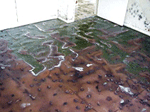 |
| |
In short, it takes several conditions for mold to grow. However, in most situations, the one element missing is moisture. Spores may begin to germinate in as little as 12 hours, and become advanced colonies of mycelia within 48 hours. Excess moisture may exist indoors as liquid water or water vapor.
| Photo courtesy of: C.R.S., Inc. |
|
 |
Liquid water, the most obvious to the homeowner can result from leaky roofs or pipes, overflows in the plumbing sewer system, chronic moisture invasions, or floods. Water vapor, or humidity is usually less obvious. Water vapor can accumulate indoors from showers or cooking without proper ventilation to release moisture to the outside. Insufficient water proofing or vapor barrier use occurs during construction, water vapor can enter through slabs and subterranean walls. Water vapor can also enter through open windows and doors in humid climates. |
Web spinner: Marshall Sigmon
Copyright © 1997-2014 [C.R.S., Inc.].
All rights reserved.
Revised:
May 01,2014
|
. |
|
|
|
|
|
 |